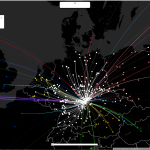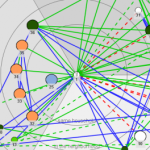A Missionary Travels: Visualising John William Arthur’s Movements Around And Between Scotland and Kenya c.1906-1938.
Background
John William Arthur who was, from 1907-1937, a missionary in the part of the world known today as ‘Kenya’, loved travel. Growing up in Glasgow he wanted to be a missionary in China or India. Eventually, like many other Scots, he followed in the footsteps of his hero David Livingstone and went to Africa. As the leader of the Church of Scotland Mission to Kenya (CSM), a position he held from 1911, he continuously moved between their three stations – Kikuyu, Tumutumu and Chogoria – each approximately 100 miles apart, each deliberately ‘remote’ – located beyond areas of white settlement. He travelled between the stations and Nairobi, the emerging capital of the colony, where he held a series of government positions. Sometimes he went by foot and camped along the way; sometimes on one of his many motorbikes; sometimes in one of his many cars; sometimes by the ‘Great Uganda Railway’ which dissected the nascent colony. On eight occasions between 1909 and 1931 Arthur journeyed north to try and climb Mount Kenya and he made one successful attempt of Mount Kilimanjaro in neighbouring Tanganyika. During the First World War, Arthur led the Kikuyu Carrier Corps, on foot, hundreds of miles through Tanganyika and German East Africa. In the 20s and 30s he went on speaking tours (about Kenya, Christianity, and Mountaineering) in Britain and the USA and holidayed with his father in the South of France. Between Mombasa and Glasgow, Arthur mostly travelled by steam boat, sometimes via the African Cape, sometimes through the Suez canal; by the end of his missionary career he was able to travel by light air-craft.
Of course Arthur travelled. He was a missionary, ‘sent by God.’ Christian mission, ‘[t]he propagation of the Christian faith among non-Christian people’, is difficult if not impossible without moving anywhere. And yet, with all the attention the modern missionary movement, or ‘colonial evangelism’, has received from historians and anthropologists in the past two decades, the journeys missionaries undertook are often relegated to minor details in analyses which focus on what missionaries did once they got to where they were going. But important things happened when missionaries like John Arthur travelled which is why I want to map and visualise Arthur’s journeys.
My research more broadly
I am undertaking a microhistory of the Church of Scotland Mission to Kenya (CSM) from about 1906 to 1938. My chief concern is to explore the lived experiences of the ordinary, mostly Scottish, men and women of the CSM. I foreground the spatial, material, and everyday, dimensions to these missionaries’ lives in order to interpret what it was like being a missionary in colonial Kenya. To this end, I embrace many of the disciplinary tools of anthropology which have energised colonial history. But this toolkit lacks what the transnational historian can provide: a critical awareness of movement through space and change over time. By tracing a specific group of actors, their specific movements, and the alterations to their bodies and minds, I hope to simultaneously meet the anthropologists’ demand for a ‘locally limited’ study with those of the historian.
Visualising Arthur’s travels
In one section of the thesis – or in one strand which will run throughout – I wish to undertake a series of close studies of some (perhaps four to six) of Arthur’s journeys. I want to visualise these journeys by using some original photographs from Arthur’s collection alongside digital maps. Particular journeys I would like to narrate, analyse and visualise include: journeys Arthur undertook between the mission stations; journeys Arthur undertook around Kenya in his capacity as head of the CSM; Arthur’s journeys to and attempts to ascend Mount Kenya; Arthur’s journeys between the Kikuyu Station and his Scottish Home base. I have the ‘raw material’: Arthur’s diaries, letters, reports are packed with geographical data. I just need to find a way of showing them in map form.
I want to include the journeys in general because they tell us interesting things about the colonial evangelists’ motivations. They were emphatically ‘transnational’: as he travelled and wrote about his journeys for home audiences Arthur invoked Moses and St. Paul; he invested his natural environment with Biblical significance: for Arthur, like missionaries in general, East Africa was a spiritual space and he was an actor in the longue durée of the 2,000 year old global expansion of Christianity. By juxtaposing Arthur’s epic and heroic descriptions of his ‘Promised Land’ with the mundane images of his journeys along with digital maps, I hope to show the imaginative work Arthur (and others) did to their own biographies.
I want to use the visualised journeys not only to emphasise the relentless mobility which characterised the missionary experience, but also to underline the material difficulties inherent to that mobility. Christian missionaries have been called ‘the most thoroughgoing facet of colonial life’ (Thomas Beidelman) and ‘the best symbol of the colonial enterprise’ (VY Mudimbe). But I am interested in the materiality of colonial enterprise(s): their spatial limits and their human actors. Whatever hegemony was secured, colonialism was not a disembodied monolithic process but the work of real, fallible human actors and their interactions in ordinary and mundane spaces and moments. An implication of much of the existing literature is that missionaries were simply ‘there’: I want to denaturalise their presence. The maps offer a visible representation of where missionaries did go and where they did not. They show the ‘arteries’ of the CSMs enterprise. Successive visualisations of similar journeys will show how these arteries changed over time: in journey time, mode of travel, and routes taken. Arthur’s journeys also tell us about shifting social networks within colonial Kenya: undertaking these journeys (as Arthur’s descriptions attest) was no simple matter: they required local knowledge and local porters, they required the hospitality of friends and, occasionally, the forging of some unlikely allegiances.
Movement is a productive process (Lefebvre; R.White). As a CSM missionary, Arthur was among the first Europeans in the highland interior of East Africa. Operating beyond the reach of the colonial state, missionaries like Arthur ‘explored’, ‘discovered’ and mountaineered; they named places and made maps; they built roads, mission stations, schools, hospitals and churches. Together with photographs and narrative analysis, digital maps of his journeys would then show not simply the mobility integral to the missionary experience but, moreover, the ‘(re)production of space’ in colonial Kenya. Arthur indeed sincerely believed that by touring the country, climbing mountains and building its infrastructure he was ‘producing’ a new space and in the process producing himself. But the production of space in colonial Kenya was a more ambiguous and haphazard process; Arthur and his environment were produced in ways which he could neither expect nor control.
 Previous Post
Previous Post Next Post
Next Post
Dear Tom,
thanks for your comment. I must admit that we have not given much thought on the question of qualitative change of objects during transfer movements yet. Changes in the quality of media news in the flow from one country to another are much easier to trace.
Some thoughts after having read your abstract: Autobiographical sketches and travel accounts are very frequent in the journals and magazines we concentrate on in our Tuebingen project. I’m afraid we have not yet come to a convincing solution of how to visualize and/or map this sector of our research field. It looks as if we had an overlapping interest in this respect?
Rolf
Dear Rolf, Thanks for taking the time to reply to my comment. We will have much to discuss on Sunday
Hi Tom,
Thanks for providing this material, it’s very interesting. I plan to read through your transcripts when my internet connectivity allows me….hopefully later this evening.
On my first reading, your quotation from Lefebvre, White, ‘Movement is a productive process’ stood out as something that highlights what you, I, and I think Alexander are trying to visualise. We all already have the travel routes of people or information across borders (John Aruther, geographical knowledge/maps, and the Gundi tobacco), and we are aware that there is something significant about the process of movement and what happens both to the object/person, and perhaps also the environment in your case (although I am wondering whether your focus is on John Arthur as affected by movement or the space he travels in affected by him?). A first tool for looking at this, as you pointed out, is actually visualiing (rather than textually describing) their movements. I wonder then what it is possible to do with these images – will they create insights that we previously have not been able to access, or they are purely didactic? (In some ways this links to a question I alluded to regarding identification of networks – what can identification of networks tell us beyond their existence?).. You alluded to this I think in your comment ‘showing the inherent mobility of missionaries’.